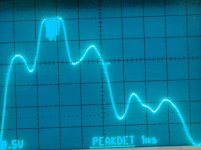ditch the Yugo 6CW5s and get some real ones from Stan - they're on their way.
I got my 6CW5's by parting out about 25 old HP audio oscillators that spent several months outside in the Florida rain. The best 6CW5's seem to be GE's. The end bells from the power transformers fit perfectly on the rusty OPT's.
In the interest of finishing at least one project this year I have decided to convert my Tube Cube NLD back to RLD operation. The last time I was poking around inside it I blew up the bias board. Another motivating factor is thes surplus LED's. The price is right and the VI curve is a straight line in the region of interest. They also have several flavors of cheap caps useful to tube tinkerers. A goodie box from them should arrive today.
SALE! LITEON LTL912SEKSA "Piranha" 3.37 Lumen Red LED-The Electronic Goldmine
Probably worth checking the dynamic impedance of those LEDs- the champs so far are the HLMP6000, which are now silly-cheap in quantity.
edit: This might also be worth checking out:
http://www.goldmine-elec-products.com/prodinfo.asp?number=G17636
edit: This might also be worth checking out:
http://www.goldmine-elec-products.com/prodinfo.asp?number=G17636
SY,
How many series strings of HLMP6000 would you use in an RLD amp? Same as the original design or less?
I found some HLMP6000 at Future Electronics for $0.19 each. Is that a fair price for small quantities?
How many series strings of HLMP6000 would you use in an RLD amp? Same as the original design or less?
I found some HLMP6000 at Future Electronics for $0.19 each. Is that a fair price for small quantities?
I just received 100 of these for a GLD.
Avago HLMP-1503-D0002 Green T1 (3mm) Diffused LED-The Electronic Goldmine
Avago HLMP-1503-D0002 Green T1 (3mm) Diffused LED-The Electronic Goldmine
Stan delivered yesterday, so I have a stash of 6CW5s of various pedigrees. The GE tubes do look nice, but so do the RCAs and Sylvanias. I'll look around today at Halted (local surplus) and see if I can find some more.
Tomorrow I'll probably try to bring up one side of the simplified NLD. The 6BQ5 version is also ready to breadboard. That being said, I'll be starting a new thread on that one soon, as it really has nothing in common with the current version (except that it's a push-pull).
Tomorrow I'll probably try to bring up one side of the simplified NLD. The 6BQ5 version is also ready to breadboard. That being said, I'll be starting a new thread on that one soon, as it really has nothing in common with the current version (except that it's a push-pull).
I populated the amp with some of the new 6CW5s I just received from ESRC - GE tubes this time around - one of the GEs was actually a yugo tube with a GE stamp on top - that one stayed in the box. One was a Zenith with GE markings underneath - that one went in instead. Anyway, with the simplified circuit, the tubes biased up just fine, no red-plating or extreme antisocial behavior, except for oscillation. The oscillation is at 2 MHz, and happens on the down-stroke. It appears to be a stage-related rather than a global loop phenomenon. I suspect it might be the NLD bias network in cahoots with the output tube, as other standard measures haven't helped tame things. Will verify and squelch. Simulation can only take you so far....
The oscillation is at 2 MHz, and happens on the down-stroke.
I have battled an oscillation phenomenon in several of my mosfet driven P-P amps. It manifests itself as a short RF burst coinciding with output tube cutoff in a class AB amp, when resistively loaded and fed with a sine wave. It appears randomly with music into speakers. Doesn't happen on SE, or class A P-P. Careful lead dress and stopper resistors with ferrite beads on the leads seem to be the magic bullet.
Attachments
SY,
How many series strings of HLMP6000 would you use in an RLD amp? Same as the original design or less?
I found some HLMP6000 at Future Electronics for $0.19 each. Is that a fair price for small quantities?
Same and yes. 😀
- Status
- Not open for further replies.
- Home
- Amplifiers
- Tubes / Valves
- "No Light District" P-P amplifier
